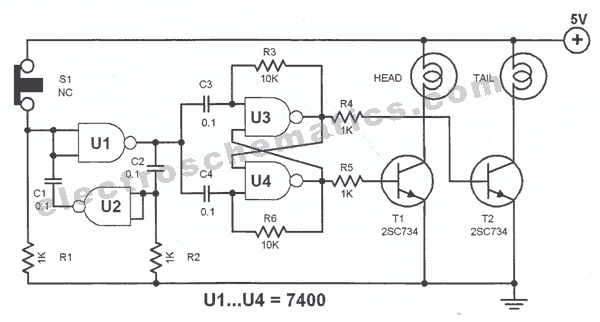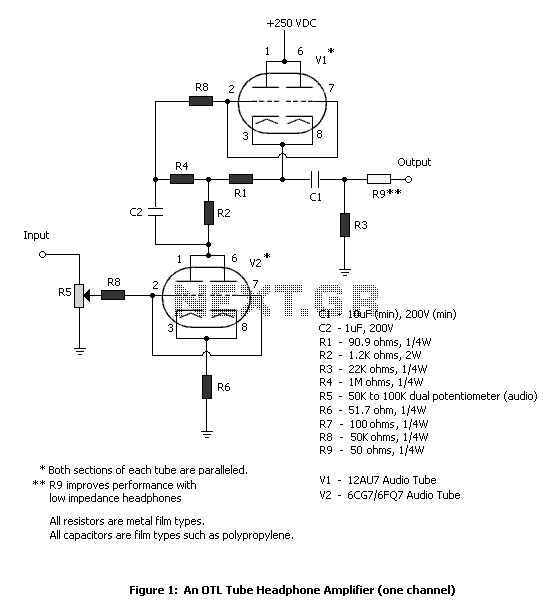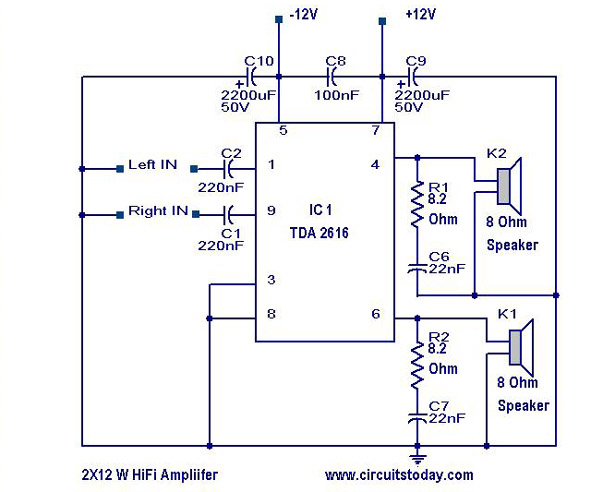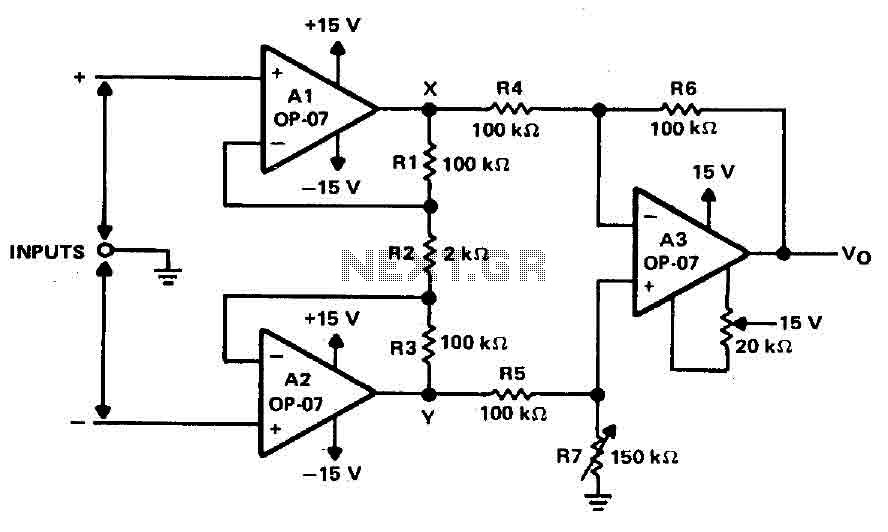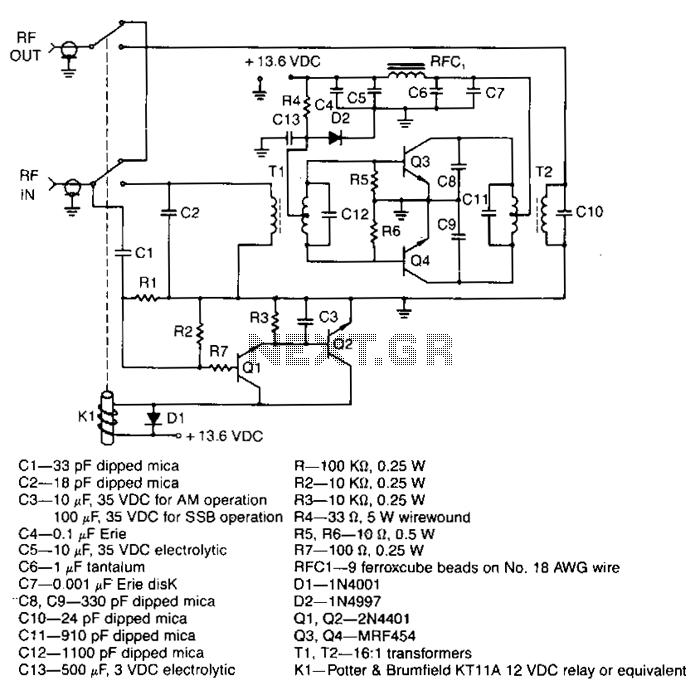
tube head amplifier

An amplifier designed to drive Sennheiser HD-600 headphones, which have a relatively high impedance. This design ensures ample voltage is available for driving the headphones. Given the large dynamic range of the headphones, the system is engineered to be very quiet. The headphones offer high resolution, leading to the decision to avoid negative feedback in the implementation of an output transformerless design. The only coupling capacitor in the signal path is the output capacitor. A relay circuit is incorporated for muting, along with a time delay to keep the output muted during warm-up, protecting the headphones from potentially high voltages at the amplifier's output. A separate chassis is utilized for the power supply to minimize noise levels. The selection of input tubes (6SN7s) is crucial for low noise performance, ensuring the circuit's full capabilities are realized. Plans exist to modify the amplifier in the future to use 12SX7 tubes, as a regulated 12 volts DC source is already available. Note that in June 2004, the conversion to 12SX7s was completed along with minor adjustments to the power supply, and the schematics below reflect these changes. The amplifier circuit operates with a 6SN7 in grounded cathode mode, self-biased using an un-bypassed cathode resistor. The input stage is directly coupled to a 6CA7 functioning as a cathode follower. The output from the 6CA7 is connected to the headphones through a 47uF capacitor, enhancing bass response. The output capacitors are further bypassed with 1uF and 0.01uF polystyrene capacitors. An Alps 'Black Beauty' volume control is implemented to preserve sonic quality and facilitate easy adjustment at low gain levels while ensuring adequate tracking between the two channels.
The amplifier circuit is meticulously designed to ensure optimal performance with the Sennheiser HD-600 headphones. The choice of a transformerless output design is particularly significant in maintaining signal integrity and minimizing distortion, which is essential for high-resolution audio reproduction. The absence of negative feedback allows for a more direct signal path, enhancing the amplifier's responsiveness and dynamic range.
The relay circuit for muting is a critical safety feature that prevents loud pops or transients from reaching the headphones during power-up, thereby protecting the delicate drivers. The time delay mechanism ensures that the amplifier stabilizes before the output is activated, further safeguarding the headphones from high voltage spikes.
Utilizing a separate chassis for the power supply is a strategic decision aimed at reducing electromagnetic interference (EMI) and hum that could degrade audio quality. This isolation helps maintain a clean power supply, which is vital for low-noise operation. The selection of low-noise tubes, such as the 6SN7, is essential for achieving the desired signal-to-noise ratio, ensuring that the amplifier can deliver clear sound without unwanted background noise.
The configuration of the 6SN7 in grounded cathode mode provides a straightforward yet effective amplification stage, while the direct coupling to the 6CA7 cathode follower stage ensures that the output impedance is lowered, allowing for better power transfer to the headphones. The use of a 47uF output capacitor is particularly noteworthy, as it not only allows for extended bass response but also couples the audio signal while blocking DC, protecting the headphones from potential damage.
The bypass capacitors (1uF and 0.01uF polystyrene) serve to filter high-frequency noise, further enhancing the clarity of the audio output. The Alps 'Black Beauty' volume control is recognized for its high-quality construction, which contributes to the overall fidelity of the audio signal. Its design allows for smooth adjustments, particularly beneficial at low gain settings where channel tracking is critical to maintaining stereo balance.
Overall, this amplifier design reflects a commitment to high-quality audio reproduction, with careful attention to component selection, circuit layout, and noise reduction strategies.An amplifier built to drive my Sennheiser HD-600 headphones. Because of the relatively high impedance of these phones, I wanted plenty of voltage available to drive them. Because of the large dynamic range possible with these phones the system had to be very quiet. A high amount of resolution is available with these headphones, so no negative feedback was employed in the execution of an output transformerless design. The only coupling capacitor in the signal path is the output cap. A relay circuit was used to provide muting and a time delay was used to keep the output muted during warm-up in order to protect the headphones from the high voltages that would otherwise be present at the output of the amplifier.
A separate chassis was used for the power supply to keep noise levels as low as possible. Selection of input tubes (6SN7s) for low noise is important in order to realize the full capability of this circuit. Since I already have a regulated source of 12 volts DC, I intend to modify this amplifier in the future to use 12SX7s.
* NOTE - (In June 2004, the conversion to 12SX7s was performed and minor changes were made to the power supply. The schematics below reflect these changes. ) The amplifier circuit is a 6SN7 run in grounded cathode mode and is self-biased using an un-bypassed cathode resistor.
The input stage is direct coupled to a 6CA7 that is used as a cathode follower. The output from the 6CA7 is coupled to the headphones using a 47uF capacitor, providing extended bass response. The output capacitors are bypassed with 1uf and. 01uF polystyrene capacitors. An Alps `Black Beauty` volume control is used to help preserver sonics and easily allows adjustment at low gain levels with adequate tracking between the two channels.
🔗 External reference
The amplifier circuit is meticulously designed to ensure optimal performance with the Sennheiser HD-600 headphones. The choice of a transformerless output design is particularly significant in maintaining signal integrity and minimizing distortion, which is essential for high-resolution audio reproduction. The absence of negative feedback allows for a more direct signal path, enhancing the amplifier's responsiveness and dynamic range.
The relay circuit for muting is a critical safety feature that prevents loud pops or transients from reaching the headphones during power-up, thereby protecting the delicate drivers. The time delay mechanism ensures that the amplifier stabilizes before the output is activated, further safeguarding the headphones from high voltage spikes.
Utilizing a separate chassis for the power supply is a strategic decision aimed at reducing electromagnetic interference (EMI) and hum that could degrade audio quality. This isolation helps maintain a clean power supply, which is vital for low-noise operation. The selection of low-noise tubes, such as the 6SN7, is essential for achieving the desired signal-to-noise ratio, ensuring that the amplifier can deliver clear sound without unwanted background noise.
The configuration of the 6SN7 in grounded cathode mode provides a straightforward yet effective amplification stage, while the direct coupling to the 6CA7 cathode follower stage ensures that the output impedance is lowered, allowing for better power transfer to the headphones. The use of a 47uF output capacitor is particularly noteworthy, as it not only allows for extended bass response but also couples the audio signal while blocking DC, protecting the headphones from potential damage.
The bypass capacitors (1uF and 0.01uF polystyrene) serve to filter high-frequency noise, further enhancing the clarity of the audio output. The Alps 'Black Beauty' volume control is recognized for its high-quality construction, which contributes to the overall fidelity of the audio signal. Its design allows for smooth adjustments, particularly beneficial at low gain settings where channel tracking is critical to maintaining stereo balance.
Overall, this amplifier design reflects a commitment to high-quality audio reproduction, with careful attention to component selection, circuit layout, and noise reduction strategies.An amplifier built to drive my Sennheiser HD-600 headphones. Because of the relatively high impedance of these phones, I wanted plenty of voltage available to drive them. Because of the large dynamic range possible with these phones the system had to be very quiet. A high amount of resolution is available with these headphones, so no negative feedback was employed in the execution of an output transformerless design. The only coupling capacitor in the signal path is the output cap. A relay circuit was used to provide muting and a time delay was used to keep the output muted during warm-up in order to protect the headphones from the high voltages that would otherwise be present at the output of the amplifier.
A separate chassis was used for the power supply to keep noise levels as low as possible. Selection of input tubes (6SN7s) for low noise is important in order to realize the full capability of this circuit. Since I already have a regulated source of 12 volts DC, I intend to modify this amplifier in the future to use 12SX7s.
* NOTE - (In June 2004, the conversion to 12SX7s was performed and minor changes were made to the power supply. The schematics below reflect these changes. ) The amplifier circuit is a 6SN7 run in grounded cathode mode and is self-biased using an un-bypassed cathode resistor.
The input stage is direct coupled to a 6CA7 that is used as a cathode follower. The output from the 6CA7 is coupled to the headphones using a 47uF capacitor, providing extended bass response. The output capacitors are bypassed with 1uf and. 01uF polystyrene capacitors. An Alps `Black Beauty` volume control is used to help preserver sonics and easily allows adjustment at low gain levels with adequate tracking between the two channels.
🔗 External reference

